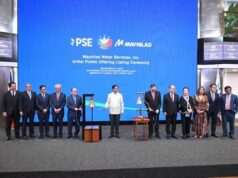THE International Monetary Fund (IMF) expects the Philippine economy to grow by 6.3% in the first three months of 2020, despite the coronavirus outbreak’s impact on tourism.
“Our annual growth rate forecast [for 2020]…is 6.3% so we expect the quarter growth to be around that range…,” IMF Resident Representative to the Philippines Yongzheng Yang said in a briefing held at the central bank on Tuesday.
The IMF maintained the growth outlook of 6.3% for the Philippines this year.
Last year, the country’s average growth was at 5.9%, higher than the 5.7% forecast by the IMF but lower than the government’s target of at least six percent.
Mr. Yang said the Philippines is “not immune” from the negative impact of the coronavirus outbreak.
“I think the major sector that comes to my mind would be tourism. China is the epicenter of this outbreak and travelling from China is now mostly as I understand stopped to this country. China is one of the largest sources of tourism for the Philippines so that is going to be negatively affected and will certainly have negative impact on the economy,” he said.
Mr. Yang also flagged the virus outbreak’s impact on the global value chain which is seen to affect the Philippines.
Preliminary estimates by the National Economic and Development Authority (NEDA) last week showed the spread of the coronavirus may hurt economic growth by 0.3% if it continues until June, or as much as 0.7% if the virus lingers until December. But if the outbreak will only be felt for one month, the impact on GDP will only be at 0.06%.
However, Mr. Yang noted that the central bank’s move to cut interest rates could somehow cushion the effects.
“The central bank here has already taken action by reducing the interest rate by 25 basis points (bps) last week and that is a good response… There’s a lot of uncertainty going on and this situation will be watched very closely to see how the world responds,” he said.
As for the Taal Volcano eruption, Mr. Yang said that while agricultural production and tourism were affected, its impact on the economy “seems to be relatively small.
According to IMF’s assessment stated in its Staff Report released last week, the central bank still has policy space to opt for a more expansionary policy stance when downside risks emerge.
From a GDP growth forecast of 6.3% in 2020, the multilateral body gave a 6.4% and 6.5% growth outlook for the Philippines for 2021 and 2022.
Mr. Yang said challenges to the implementation of the government’s infrastructure programs could pose risks to further economic expansion, adding that “the remaining infrastructure programs are more complex and challenging to implement.”
“Therefore in order to achieve more investment flows, we need to tackle the underlying structural impediments. These efforts should include ..improving the planning and implementation capacity especially at the local government level,” he added. — Luz Wendy T. Noble



